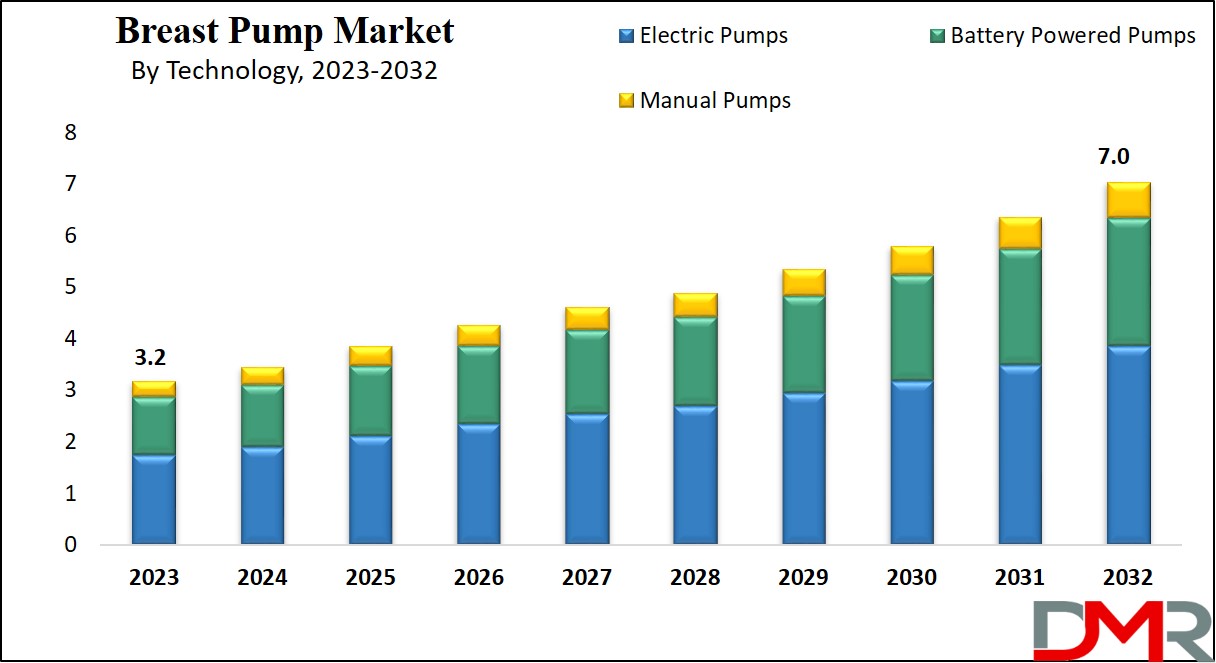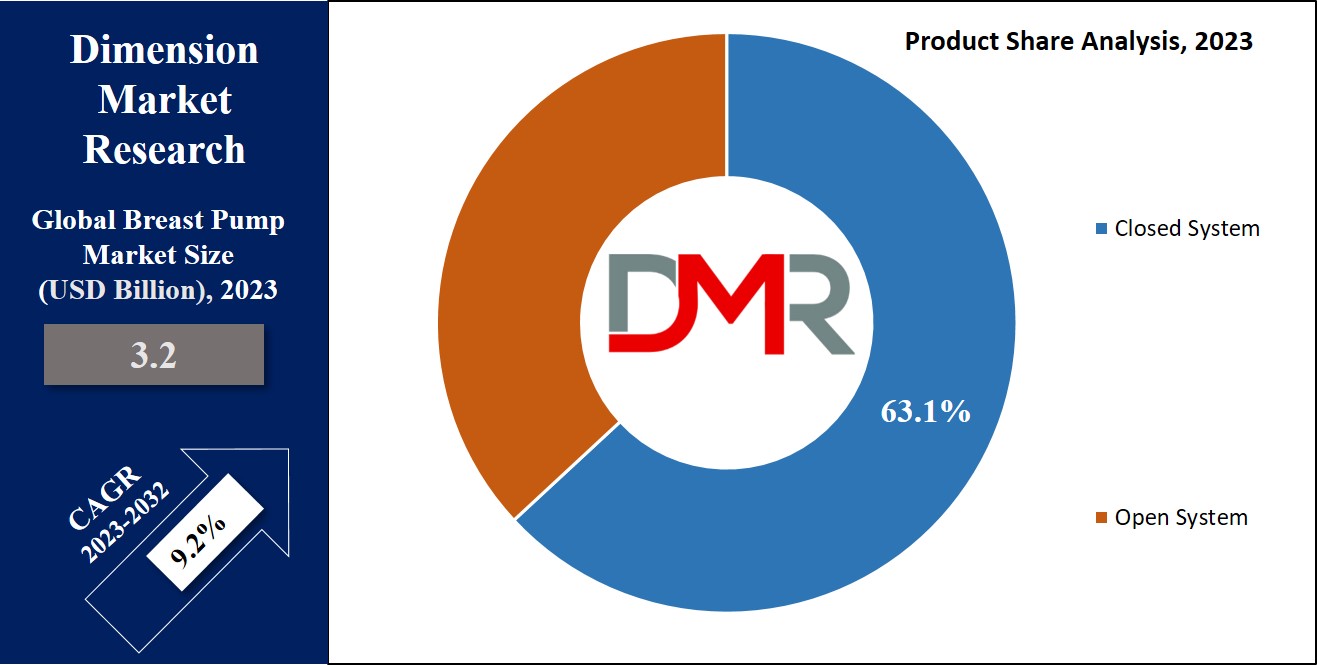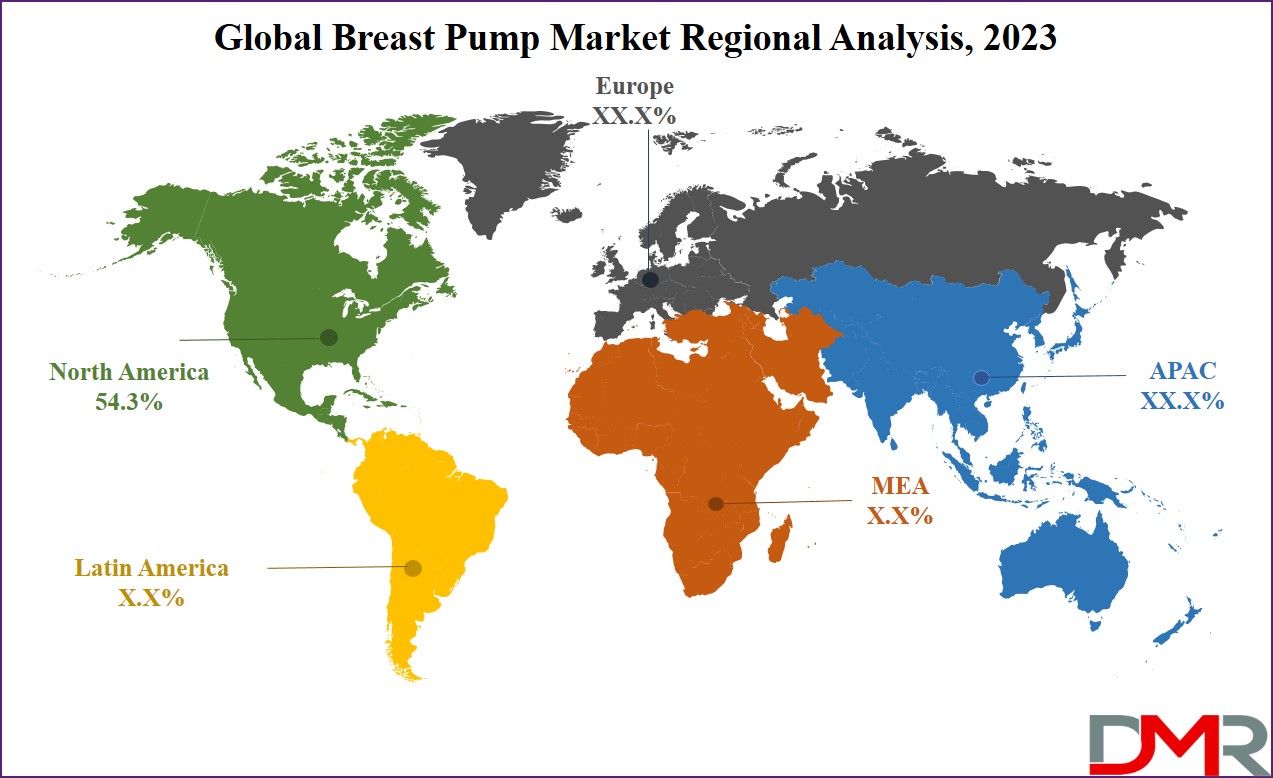Market Overview
The Global Breast Pump Market is expected to be valued at USD 3.2 billion in 2023 & USD 7.0 billion in 2032, and projections indicate a CAGR of 9.2% for the forecasted period of 2023 to 2032.
A breast pump is a mechanical medical device that is used to extract milk from lactating women. Breast pumps are particularly used to maintain and alleviate engorged breasts and obstructed milk ducts. Most doctors suggest using breast pumps when the infants are unable to latch on and feed at the breast.

Breastfeeding is also prescribed by healthcare professionals globally as breast milk protects infants from a variety of diseases since it provides them with acquired immunity to fight antigens.
Breast milk also contains antibodies and immunoglobulins, such as IgA, IgM, and IgG, that help infants fight off diseases. Also, the growing awareness about the benefits of breastfeeding and the emphasis on maternal and infant health propel the global breast pump market to grow further.
Interestingly, technological integration in healthcare devices like the insulin pump, infusion pump, and even industrial tools like the
centrifugal pump highlights a broader trend toward personalized, efficient, and patient-friendly technology — a trend also driving the evolution of modern breast pumps.
Market Dynamic
The global breast pump market is experiencing dynamic shifts driven by various factors such as rising awareness, technological advancements, and changing consumer preferences. The rising awareness among consumers and supportive government programs are expected to drive the growth of the global breast pump market.
For example, the Baby Friendly Hospital Initiative (BFHI), established by the United Nations Children's Fund (UNICEF) and the World Health Organization (WHO), extensively promotes the benefits of breastfeeding to infants. The market continues to expand due to extensive advertising by online retail channels and global efforts to support breastfeeding.
Furthermore, economic factors such as the rise in disposable income and insurance coverage majorly influence the purchasing power of consumers and also reflect on their decisions. Ongoing research and development contribute to the market's evolution and the introduction of portable devices further fuels growth. Overall, the breast pump market reflects a dynamic landscape shaped by health trends, technological advancements, and evolving consumer needs.
Research Scope and Analysis
By Product
In terms of by by-product segment, closed systems dominate this segment as it holds 63.1% of the market share in 2023 and is anticipated to show significant growth in the upcoming period of 2023 to 2032.
The growth of closed-system breast pumps in this segment can be primarily attributed to their higher utilization rates, given their comparatively superior hygiene standards & reduced risk of contamination.
Closed-system breast pumps are specially designed where they have a barrier between the breast milk and the pump's motor and tubes. This design minimizes the risk of contamination and infection, providing a hygienic solution to mothers while using breast pumps. The closed system helps prevent milk particles or microorganisms from entering the pump's internal components.
Moreover, closed-system breast pumps are more popular than open-system breast pumps for their durability. The sealed design of the closed-system breast pump protects the motor and other components from potential damage caused by milk or other substances entering the system. This durability contributes to a longer lifespan for the closed system pump, making it a cost-effective choice for both healthcare facilities and domestic users.
By Technology
The global breast pump market, by technology segment, is categorized into electric, manual & battery-powered pumps, among which the electronic pumps take the lead in 2023 as they hold 54.9% of the market share in 2023 and are projected to maintain their dominance throughout the forecasted period of 2023 to 2032.
As the electronic pump dominates this segment, it can be attributed to their efficiency and convenience as they use motorized mechanisms to automatically create a pumping action, allowing mothers to collect milk more quickly and with less manual effort compared to manual pumps.
Electric breast pumps are often also preferred by working mothers due to their efficiency and effectiveness. Many electric pumps are specially designed for daily use, which makes them particularly valuable for busy mothers who may have limited time for breastfeeding.
Moreover, electric pumps often come with adjustable suction and speed settings which provide mothers with the flexibility to customize the settings of the pump according to their own comfort. This feature enhances the overall user experience, contributing to the popularity of electric pumps and solidifying their position in the breast pump market.
Similar advancements can be seen in devices like the
insulin pump and infusion pump, which rely on automation, precision, and user-friendly interfaces to improve patient outcomes — aligning with trends in breast pump innovations.
By Application
The global breast pump market by application segment is categorized into personal use and hospital-grade. Among these, the hospital-grade breast pump is anticipated to show significant growth during the forecast period, which can be attributed to its design for use in clinical settings and healthcare facilities.
These pumps are typically more durable and efficient, which makes them suitable for heavy and prolonged use. In hospitals, these products are used in maternity wards by mothers of preterm infants or babies with specific health needs.

These pumps are specifically designed to provide optimal suction and facilitate the expression of breast milk, supporting the nutritional needs of vulnerable infants in a hospital environment.
Furthermore, hospital-grade breast pumps are kept in strict hygiene and safety standards as it is crucial in hospitals where multiple users may use the same equipment. Their special emphasis on safety and infection control makes these breast pumps more suitable for use in hospitals, ensuring the well-being of both mothers and infants.
The increasing technological overlap between maternal care tools and advanced devices like the centrifugal pump,
infusion pump, and AI-integrated imaging reflects a broader shift toward high-efficiency, intelligent healthcare solutions.
The Breast Pump Market Report is segmented based on the following:
By Product
- Closed System
- Open System
By Technology
- Electric Pumps
- Manual Pumps
- Battery-Powered Pumps
By Application
- Personal Use
- Hospital Grade
Regional Analysis
The North American region commands a substantial 54.3% share of the global breast pump market in 2023, with the United States and Canada emerging as its dominant force. In this region, particularly the United States and Canada, mothers show a high level of awareness regarding the benefits of breastfeeding and the use of breast pumps, which has led to the increased use of breast pumps among new mothers, contributing to its dominance in this market.
Another factor that contributes to this region's dominance in this market is that the consumer base here has relatively higher disposable incomes in comparison to other regions. Their financial capacity allows these families to invest in breastfeeding-related products, including advanced and more expensive breast pump models.

Additionally, in some cases this region provides health insurance policies to individuals that cover the cost of breast pumps, making them more accessible to a larger segment of the population. This financial support encourages mothers to use breast pumps, thereby driving the growth of this market and also strengthening the position of North America in the global breast pump market.
By Region
North America
Europe
- Germany
- The U.K.
- France
- Italy
- Russia
- Spain
- Benelux
- Nordic
- Rest of Europe
Asia-Pacific
- China
- Japan
- South Korea
- India
- ANZ
- ASEAN
- Rest of Asia-Pacific
Latin America
- Brazil
- Mexico
- Argentina
- Colombia
- Rest of Latin America
Middle East & Africa
- Saudi Arabia
- UAE
- South Africa
- Israel
- Egypt
- Rest of MEA
Competitive Landscape
The global breast pump market has several well-established companies like Medela, Philips, Ameda, and Spectra which are recognized as key players and hold a significant portion of this market. These companies have a long-standing presence in this market and are popular for producing a wide range of breast pump models catering to different user needs.
The competitive landscape of this market consists of various factors that affect its growth. These companies compete with each other to develop breast pumps with advanced features, user-friendly designs, and enhanced efficiency.
Innovations may include quieter operation, portability, smart technology integration, and customization options to gain a competitive edge over others. Many beast pump manufacturers are now focusing on expanding their market presence by entering new geographical regions by using strategic partnerships, collaborations, and distribution agreements to reach a wider customer base.
Some of the prominent players in the Global Breast Pump Market are:
- Ameda
- Hygeia Health
- Medela AG
- Koninklijke Philips N.V.
- Lansinoh Laboratories Inc.
- Pigeon Corporation
- Motif Medical
- Chiaro Technology Limited
- Willow Innovations Inc.
- Spectra Baby USA
- Other Key Players
Recent Developments
- In January 2024, Annabella, the first of its kind breast pump, announces its U.S. expansion along with securing seed funding. The innovative pump aims to revolutionize femtech by improving the breastfeeding experience for mothers.
- In April 2025, Willow acquires Elvie to strengthen its maternal health technology portfolio. This acquisition marks a significant move to enhance product offerings in the growing femtech market.
- In March 2025, Elvie enters administration and is subsequently acquired by U.S. competitor, Willow. The acquisition aims to consolidate Willow's position as a leader in maternal health tech and expand its global reach.
Report Details
| Report Characteristics |
| Market Size (2023) |
USD 3.2 Bn |
| Forecast Value (2032) |
USD 7.0 Bn |
| CAGR (2023-2032) |
9.2% |
| Historical Data |
2017 - 2022 |
| Forecast Data |
2023 - 2032 |
| Base Year |
2022 |
| Estimate Year |
2023 |
| Report Coverage |
Market Revenue Estimation, Market Dynamics, Competitive Landscape, Growth Factors and etc. |
| Segments Covered |
By Product (Closed System and Open System), By Technology (Electric Pumps, Manual Pumps and Battery Powered Pumps), By Application (Personal Use and Hospital Grade) |
| Regional Coverage |
North America – The US and Canada; Europe – Germany, The UK, France, Russia, Spain, Italy, Benelux, Nordic, & Rest of Europe; Asia- Pacific– China, Japan, South Korea, India, ANZ, ASEAN, Rest of APAC; Latin America – Brazil, Mexico, Argentina, Colombia, Rest of Latin America; Middle East & Africa – Saudi Arabia, UAE, South Africa, Turkey, Egypt, Israel, & Rest of MEA |
| Prominent Players |
Ameda, Hygeia Health, Medela AG, Koninklijke Philips N.V., Lansinoh Laboratories Inc., Pigeon Corporation, Motif Medical, Chiaro Technology Limited, Willow Innovations Inc., Spectra Baby USA, and Other Key Players |
| Purchase Options |
We have three licenses to opt for: Single User License (Limited to 1 user), Multi-User License (Up to 5 Users), and Corporate Use License (Unlimited User) along with free report customization equivalent to 0 analyst working days, 3 analysts working days and 5 analysts working days respectively. |
Frequently Asked Questions
The Global Breast Pump Market is expected to attain a valuation of USD 3.2 billion in 2023.
The expected CAGR for the Global Breast Pump Market is 9.2% for the forecasted period of 2023 to
2032.
The North American segment asserts its market dominance, capturing a significant revenue share of
over 54.3% in the year 2023.
Some of the prominent players in the Global Breast Pump Market include Ameda, Hygeia Health,
Medela AG, Koninklijke Philips N.V., Lansinoh Laboratories Inc., Pigeon Corporation, Motif Medical,
Chiaro Technology Limited, Willow Innovations Inc., Spectra Baby USA etc.